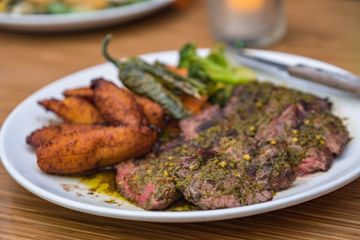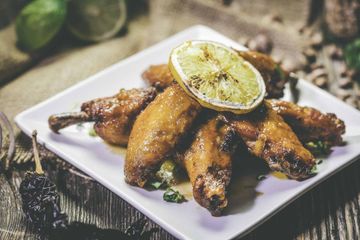Make your evenings exciting with happy hour and enjoy classic Mexican drinks
What Are the Vital Meals That Define Mexican Cuisine?
Mexican cuisine is a vivid representation of its cultural heritage, characterized by a selection of important meals. Tacos, mole, pozole, tamales, and ceviche each inform a distinct tale of practice and flavor. These foods not just satisfy the taste yet likewise symbolize the spirit of community and party. Understanding their significance reveals much concerning Mexico's cooking identity. What lies underneath the surface of these precious dishes?

Tacos: The Quintessential Street Food
Tacos are commonly considered as the perfect street food of Mexico, commemorated for their adaptability and abundant flavors. They contain a straightforward tortilla, typically made from corn or flour, filled up with a variety of ingredients that can range from barbequed meats to vegetables. This versatility permits countless local variations, each showcasing neighborhood flavors and traditions.
Popular dental fillings consist of carne asada, carnitas, and pollo, typically accompanied by fresh garnishes like cilantro, onions, and lime. Road suppliers skillfully prepare and serve tacos, making them a hassle-free and economical choice for locals and vacationers alike.
The experience of eating tacos is enhanced by the lively atmosphere of Mexican roads, where the aroma of seasonings and sizzling meat fills up the air. This legendary meal not just satisfies hunger but also represents the social richness of Mexico, reflecting its history, neighborhood, and culinary virtuosity.
Mole: A Harmony of Flavors
Mole symbolizes the intricacy and deepness of Mexican cuisine, offering an abundant tapestry of flavors that astound the taste buds. This sauce, frequently made with a mix of chilies, spices, nuts, and chocolate, showcases the artistry and social heritage of Mexico. Each area boasts its special analysis, with variants such as mole poblano and mole , showing regional components and practices.
The prep work of mole is a complex procedure, calling for skill and persistence as the components are meticulously toasted, ground, and simmered to excellence. The resulting sauce can range from full-flavored to wonderful, with layers of flavor that advance with each bite. Generally offered over poultry or turkey, mole goes beyond plain nutrition, commonly gracing special events and parties. Its lively shade and complicated profile represent the rich culinary identification of Mexico, making it an essential meal that resonates with both visitors and locals alike.
Pozole: A Hearty Tradition
Although typically delighted in throughout festive events, pozole is a meal deeply rooted in Mexican tradition, embodying both social importance and common spirit. This hearty soup, made mainly from hominy, meat-- normally pork or poultry-- and a rich brew, has ancient origins that map back to pre-Columbian human beings. Traditionally planned for parties such as Mexican Self-reliance Day and weddings, pozole transcends simple food, promoting a feeling of unity among those who partake.
The meal comes in various regional variations, including pozole rojo, blanco, and verde, each identified by its unique components and taste profiles. Toppings such as shredded cabbage, radishes, avocado, and lime boost the recipe, enabling individual expression. Past its delicious high qualities, pozole functions as an icon of heritage, connecting generations through shared recipes and cooking techniques. Its prep work often ends up being a common event, strengthening bonds amongst family and buddies, making it a real symbol of Mexican hospitality.
Tamales: Wrapped in Love
Tamales hold an unique place in Mexican food, just like pozole, celebrating tradition and community. These wonderful parcels of masa, or corn dough, are normally full of a range of components, consisting of meats, cheeses, fruits, or veggies, and continue reading this after that wrapped in corn husks or banana leaves prior to being steamed to perfection - hand crafted margarita. The preparation of tamales typically entails family events, where generations collaborated to share the labor of mixing, filling, and wrapping, strengthening their relevance as a common dish
Tamales are particularly prominent during cheery occasions, such as Xmas and Día de los Muertos, representing a connection to cultural heritage. They are not just food; they embody love, care, and the passing down of culinary abilities. Each region in Mexico boasts its own one-of-a-kind variations, showcasing neighborhood tastes and traditions, making tamales a precious staple that transcends generations and unifies individuals across the nation.
Ceviche: A Fresh Coastal Delight
Ceviche, a vibrant dish rooted in the seaside areas of Mexico, showcases the quality of the ocean's bounty. Traditionally made with raw fish seasoned in citrus juices, particularly lime, ceviche is commemorated for its sakana sushi invigorating flavor account. The acidity from the lime "cooks" the fish, causing a tender appearance that sets beautifully with the intense components commonly consisted of, such as diced tomatoes, onions, cilantro, and chili peppers.
Regions like Baja California and the Yucatán Peninsula have their own distinctive versions, incorporating local fish and shellfish such as shrimp, octopus, or scallops. Served chilled, ceviche is frequently come with by tortilla chips or tostadas, improving its charm as a popular appetizer or light meal. This dish not just shows the abundant aquatic life of Mexico however likewise highlights the cultural significance of fresh, local active ingredients in Mexican gastronomy. Ceviche stays a beloved depiction of coastal culinary customs.
Often Asked Concerns
What Are the Key Ingredients in Traditional Mexican Food?
Trick ingredients in typical Mexican food include corn, beans, avocados, chilies, and tomatoes. hand crafted margarita. These staples create the structure of lots of recipes, showing the vivid tastes and diverse culinary heritage of Mexico's abundant gastronomic landscape
Exactly How Has Mexican Food Advanced Over Time?
Mexican cuisine has actually progressed through centuries, influenced by indigenous traditions, Spanish emigration, and global active ingredients. This vibrant blend has led to diverse regional flavors, methods, and dishes that remain to adapt and innovate with modern cooking trends.

What Are Usual Dietary Restrictions in Mexican Cooking?
Common nutritional restrictions in Mexican food preparation include gluten, veganism, and vegetarianism intolerance. Many conventional meals can be adapted to suit these choices, guaranteeing that flavors stay dynamic while appreciating individual cultural methods and nutritional demands.
How Do Regional Variations Influence Mexican Recipes?
Regional variants greatly affect Mexican recipes with neighborhood components, conventional food preparation methods, and social influences. Each area's page unique climate and history contribute distinctive tastes, methods, and recipes, leading to an abundant culinary diversity throughout the nation.
What Beverages Set Best With Mexican Food?
Traditional Mexican cuisine pairs well with drinks like horchata, aguas frescas, and tequila. Craft beers and mezcal also complement the tastes, improving the dining experience with their unique accounts and invigorating features.
Mexican food is a lively reflection of its social heritage, defined by a selection of important dishes. Mole personifies the complexity and deepness of Mexican cuisine, providing an abundant tapestry of flavors that captivate the taste. Frequently delighted in throughout cheery celebrations, pozole is a meal deeply rooted in Mexican practice, symbolizing both cultural relevance and common spirit. Mexican food has developed through centuries, influenced by aboriginal customs, Spanish colonization, and worldwide components. Regional variations substantially affect Mexican meals with regional components, traditional cooking methods, and social influences.